Detailed Report: Enterprise Architecture for the GovDept's Operations
VerifiedAdded on 2023/01/12
|10
|2613
|40
Report
AI Summary
This report provides a comprehensive analysis of the Enterprise Architecture (EA) implementation for GovDept, a mid-sized governmental department. The report begins by identifying key projects for GovDept, including investments in updated hardware, software, and an Enterprise Resource Planning (ERP) system, to enhance operational performance and reduce costs. It then outlines the pivotal roles of IT in GovDept's operations, emphasizing its ability to improve data storage, analysis, communication, decision-making, and resource management. The report explores the advantageous outcomes of EA integration, such as structured IT processes and industry frameworks. It delves into document classification methods, specifically highlighting the Naïve Bayes classifiers. The report assesses the coordination operating model, standards and landscapes, and 5 types of IT initiatives, with considerations. Finally, the report discusses 5 subtypes of visions and concludes that EA is crucial for structuring IT policies and achieving optimal performance within GovDept.
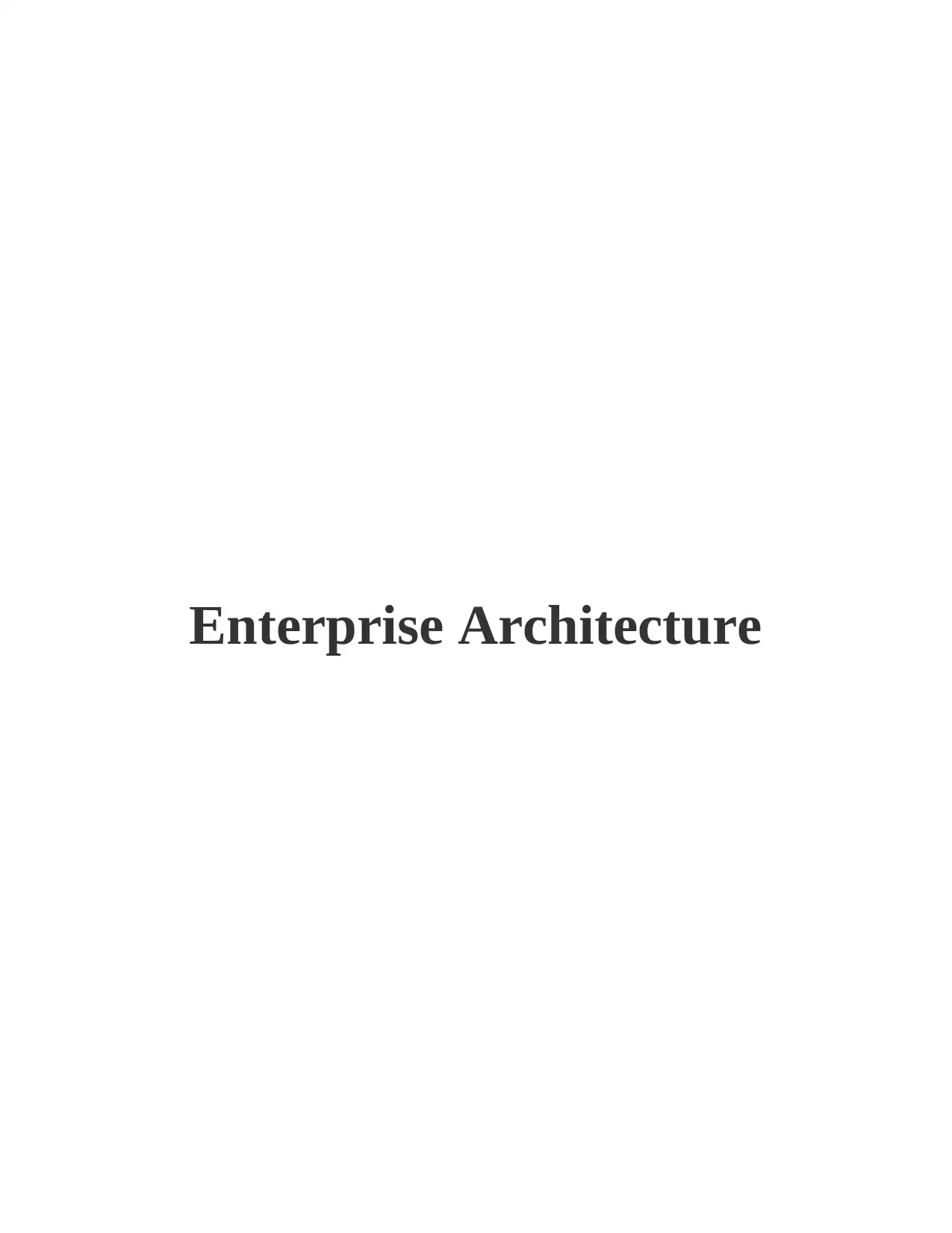
Enterprise Architecture
Paraphrase This Document
Need a fresh take? Get an instant paraphrase of this document with our AI Paraphraser
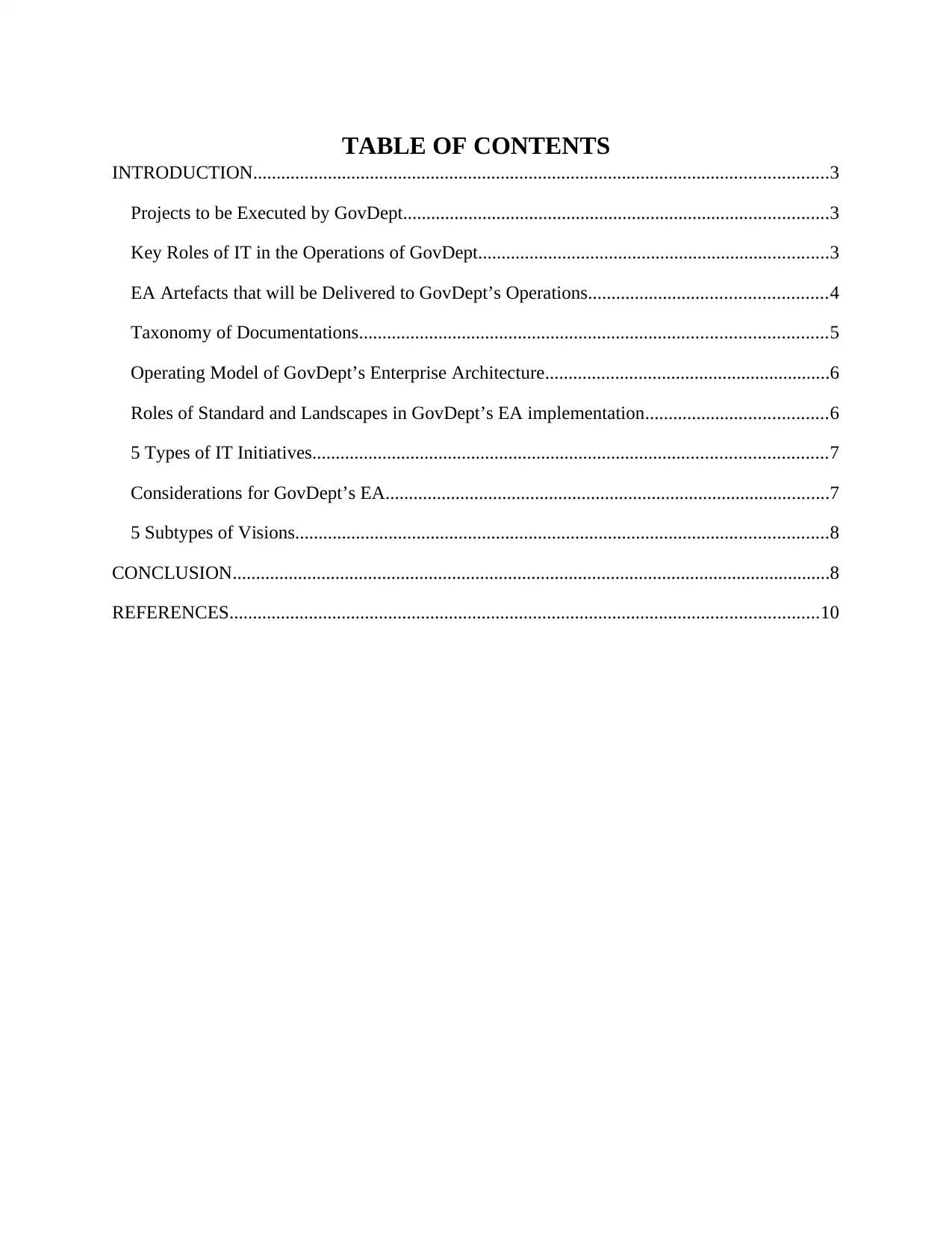
TABLE OF CONTENTS
INTRODUCTION...........................................................................................................................3
Projects to be Executed by GovDept...........................................................................................3
Key Roles of IT in the Operations of GovDept...........................................................................3
EA Artefacts that will be Delivered to GovDept’s Operations...................................................4
Taxonomy of Documentations....................................................................................................5
Operating Model of GovDept’s Enterprise Architecture.............................................................6
Roles of Standard and Landscapes in GovDept’s EA implementation.......................................6
5 Types of IT Initiatives..............................................................................................................7
Considerations for GovDept’s EA...............................................................................................7
5 Subtypes of Visions..................................................................................................................8
CONCLUSION................................................................................................................................8
REFERENCES..............................................................................................................................10
INTRODUCTION...........................................................................................................................3
Projects to be Executed by GovDept...........................................................................................3
Key Roles of IT in the Operations of GovDept...........................................................................3
EA Artefacts that will be Delivered to GovDept’s Operations...................................................4
Taxonomy of Documentations....................................................................................................5
Operating Model of GovDept’s Enterprise Architecture.............................................................6
Roles of Standard and Landscapes in GovDept’s EA implementation.......................................6
5 Types of IT Initiatives..............................................................................................................7
Considerations for GovDept’s EA...............................................................................................7
5 Subtypes of Visions..................................................................................................................8
CONCLUSION................................................................................................................................8
REFERENCES..............................................................................................................................10
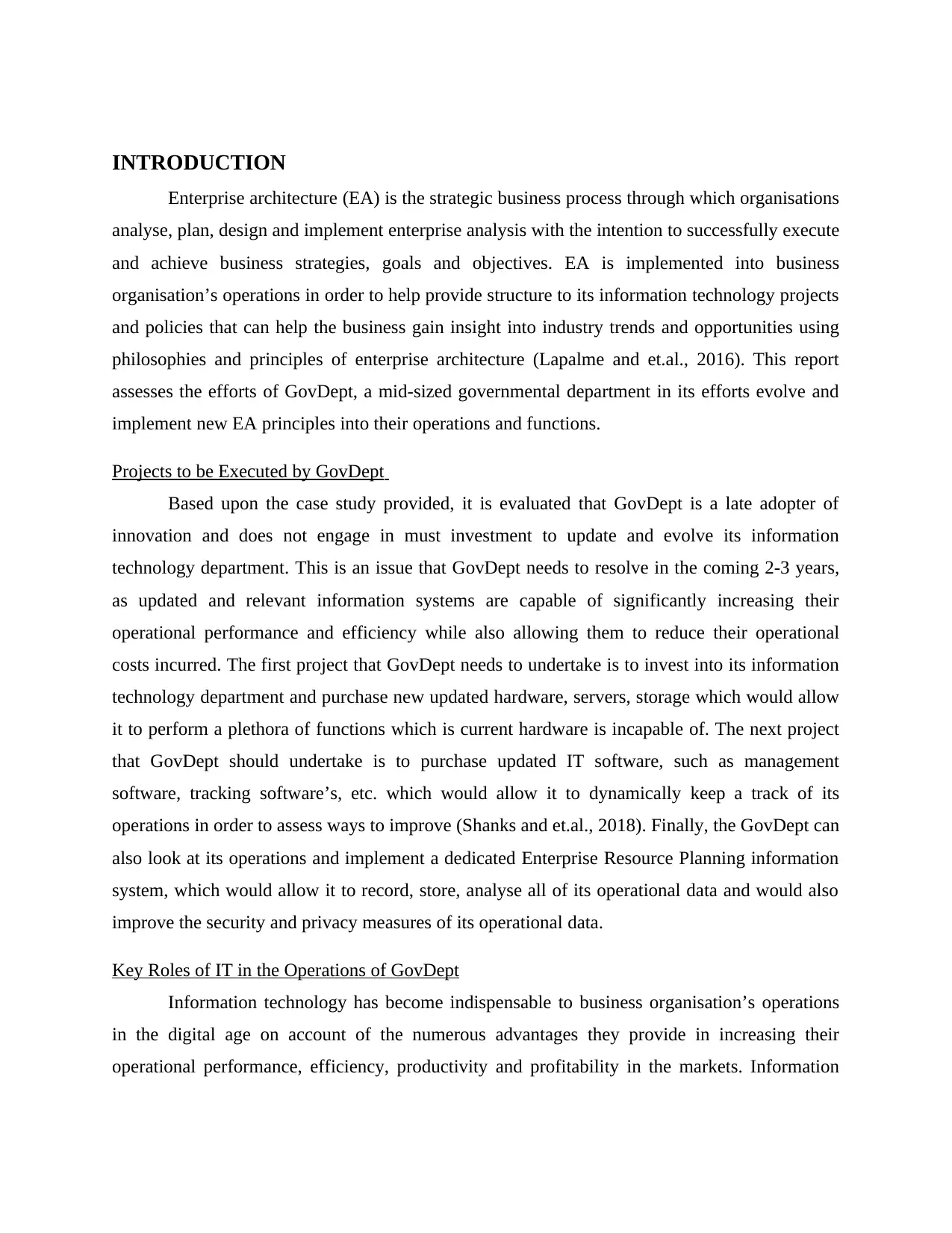
INTRODUCTION
Enterprise architecture (EA) is the strategic business process through which organisations
analyse, plan, design and implement enterprise analysis with the intention to successfully execute
and achieve business strategies, goals and objectives. EA is implemented into business
organisation’s operations in order to help provide structure to its information technology projects
and policies that can help the business gain insight into industry trends and opportunities using
philosophies and principles of enterprise architecture (Lapalme and et.al., 2016). This report
assesses the efforts of GovDept, a mid-sized governmental department in its efforts evolve and
implement new EA principles into their operations and functions.
Projects to be Executed by GovDept
Based upon the case study provided, it is evaluated that GovDept is a late adopter of
innovation and does not engage in must investment to update and evolve its information
technology department. This is an issue that GovDept needs to resolve in the coming 2-3 years,
as updated and relevant information systems are capable of significantly increasing their
operational performance and efficiency while also allowing them to reduce their operational
costs incurred. The first project that GovDept needs to undertake is to invest into its information
technology department and purchase new updated hardware, servers, storage which would allow
it to perform a plethora of functions which is current hardware is incapable of. The next project
that GovDept should undertake is to purchase updated IT software, such as management
software, tracking software’s, etc. which would allow it to dynamically keep a track of its
operations in order to assess ways to improve (Shanks and et.al., 2018). Finally, the GovDept can
also look at its operations and implement a dedicated Enterprise Resource Planning information
system, which would allow it to record, store, analyse all of its operational data and would also
improve the security and privacy measures of its operational data.
Key Roles of IT in the Operations of GovDept
Information technology has become indispensable to business organisation’s operations
in the digital age on account of the numerous advantages they provide in increasing their
operational performance, efficiency, productivity and profitability in the markets. Information
Enterprise architecture (EA) is the strategic business process through which organisations
analyse, plan, design and implement enterprise analysis with the intention to successfully execute
and achieve business strategies, goals and objectives. EA is implemented into business
organisation’s operations in order to help provide structure to its information technology projects
and policies that can help the business gain insight into industry trends and opportunities using
philosophies and principles of enterprise architecture (Lapalme and et.al., 2016). This report
assesses the efforts of GovDept, a mid-sized governmental department in its efforts evolve and
implement new EA principles into their operations and functions.
Projects to be Executed by GovDept
Based upon the case study provided, it is evaluated that GovDept is a late adopter of
innovation and does not engage in must investment to update and evolve its information
technology department. This is an issue that GovDept needs to resolve in the coming 2-3 years,
as updated and relevant information systems are capable of significantly increasing their
operational performance and efficiency while also allowing them to reduce their operational
costs incurred. The first project that GovDept needs to undertake is to invest into its information
technology department and purchase new updated hardware, servers, storage which would allow
it to perform a plethora of functions which is current hardware is incapable of. The next project
that GovDept should undertake is to purchase updated IT software, such as management
software, tracking software’s, etc. which would allow it to dynamically keep a track of its
operations in order to assess ways to improve (Shanks and et.al., 2018). Finally, the GovDept can
also look at its operations and implement a dedicated Enterprise Resource Planning information
system, which would allow it to record, store, analyse all of its operational data and would also
improve the security and privacy measures of its operational data.
Key Roles of IT in the Operations of GovDept
Information technology has become indispensable to business organisation’s operations
in the digital age on account of the numerous advantages they provide in increasing their
operational performance, efficiency, productivity and profitability in the markets. Information
⊘ This is a preview!⊘
Do you want full access?
Subscribe today to unlock all pages.

Trusted by 1+ million students worldwide
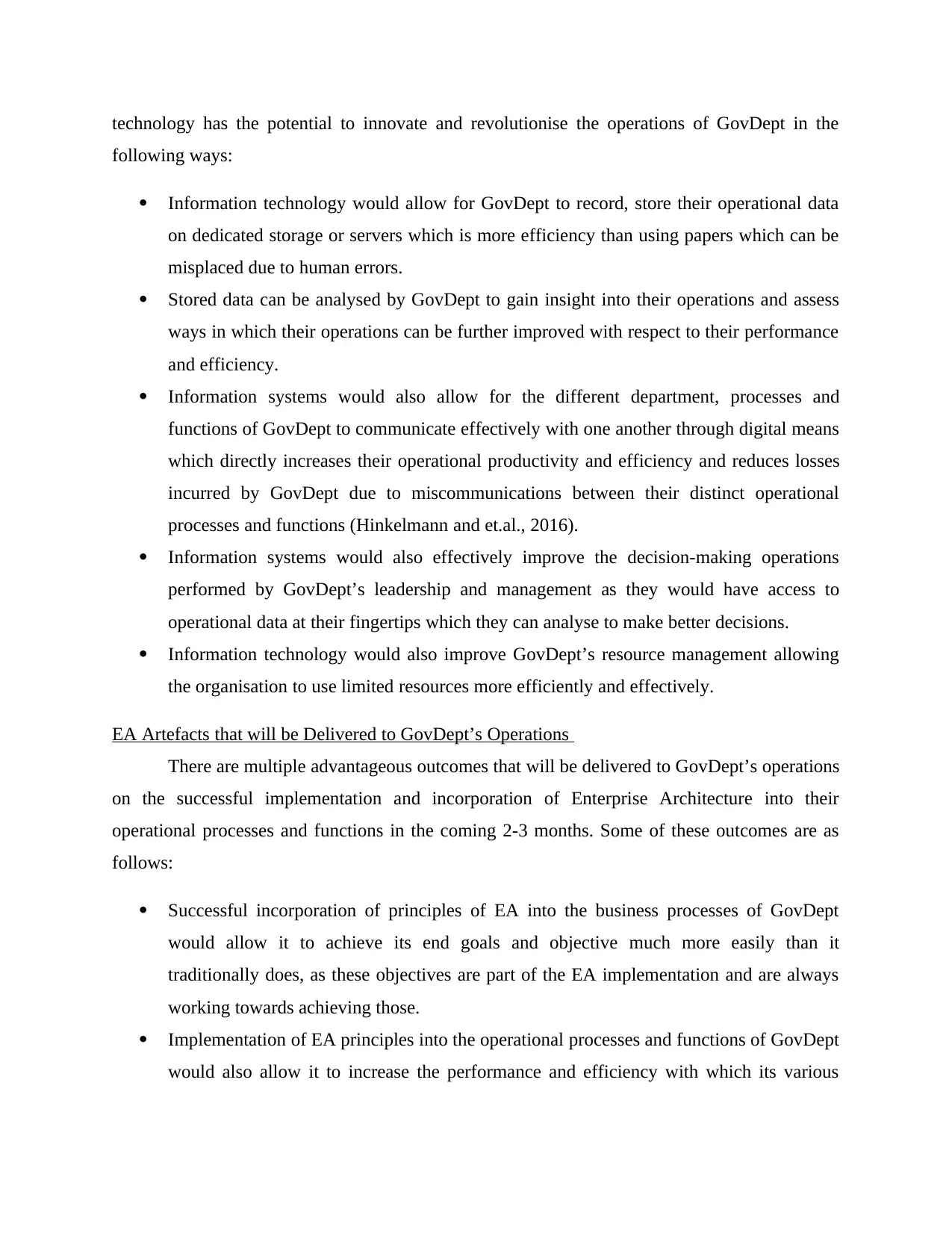
technology has the potential to innovate and revolutionise the operations of GovDept in the
following ways:
Information technology would allow for GovDept to record, store their operational data
on dedicated storage or servers which is more efficiency than using papers which can be
misplaced due to human errors.
Stored data can be analysed by GovDept to gain insight into their operations and assess
ways in which their operations can be further improved with respect to their performance
and efficiency.
Information systems would also allow for the different department, processes and
functions of GovDept to communicate effectively with one another through digital means
which directly increases their operational productivity and efficiency and reduces losses
incurred by GovDept due to miscommunications between their distinct operational
processes and functions (Hinkelmann and et.al., 2016).
Information systems would also effectively improve the decision-making operations
performed by GovDept’s leadership and management as they would have access to
operational data at their fingertips which they can analyse to make better decisions.
Information technology would also improve GovDept’s resource management allowing
the organisation to use limited resources more efficiently and effectively.
EA Artefacts that will be Delivered to GovDept’s Operations
There are multiple advantageous outcomes that will be delivered to GovDept’s operations
on the successful implementation and incorporation of Enterprise Architecture into their
operational processes and functions in the coming 2-3 months. Some of these outcomes are as
follows:
Successful incorporation of principles of EA into the business processes of GovDept
would allow it to achieve its end goals and objective much more easily than it
traditionally does, as these objectives are part of the EA implementation and are always
working towards achieving those.
Implementation of EA principles into the operational processes and functions of GovDept
would also allow it to increase the performance and efficiency with which its various
following ways:
Information technology would allow for GovDept to record, store their operational data
on dedicated storage or servers which is more efficiency than using papers which can be
misplaced due to human errors.
Stored data can be analysed by GovDept to gain insight into their operations and assess
ways in which their operations can be further improved with respect to their performance
and efficiency.
Information systems would also allow for the different department, processes and
functions of GovDept to communicate effectively with one another through digital means
which directly increases their operational productivity and efficiency and reduces losses
incurred by GovDept due to miscommunications between their distinct operational
processes and functions (Hinkelmann and et.al., 2016).
Information systems would also effectively improve the decision-making operations
performed by GovDept’s leadership and management as they would have access to
operational data at their fingertips which they can analyse to make better decisions.
Information technology would also improve GovDept’s resource management allowing
the organisation to use limited resources more efficiently and effectively.
EA Artefacts that will be Delivered to GovDept’s Operations
There are multiple advantageous outcomes that will be delivered to GovDept’s operations
on the successful implementation and incorporation of Enterprise Architecture into their
operational processes and functions in the coming 2-3 months. Some of these outcomes are as
follows:
Successful incorporation of principles of EA into the business processes of GovDept
would allow it to achieve its end goals and objective much more easily than it
traditionally does, as these objectives are part of the EA implementation and are always
working towards achieving those.
Implementation of EA principles into the operational processes and functions of GovDept
would also allow it to increase the performance and efficiency with which its various
Paraphrase This Document
Need a fresh take? Get an instant paraphrase of this document with our AI Paraphraser
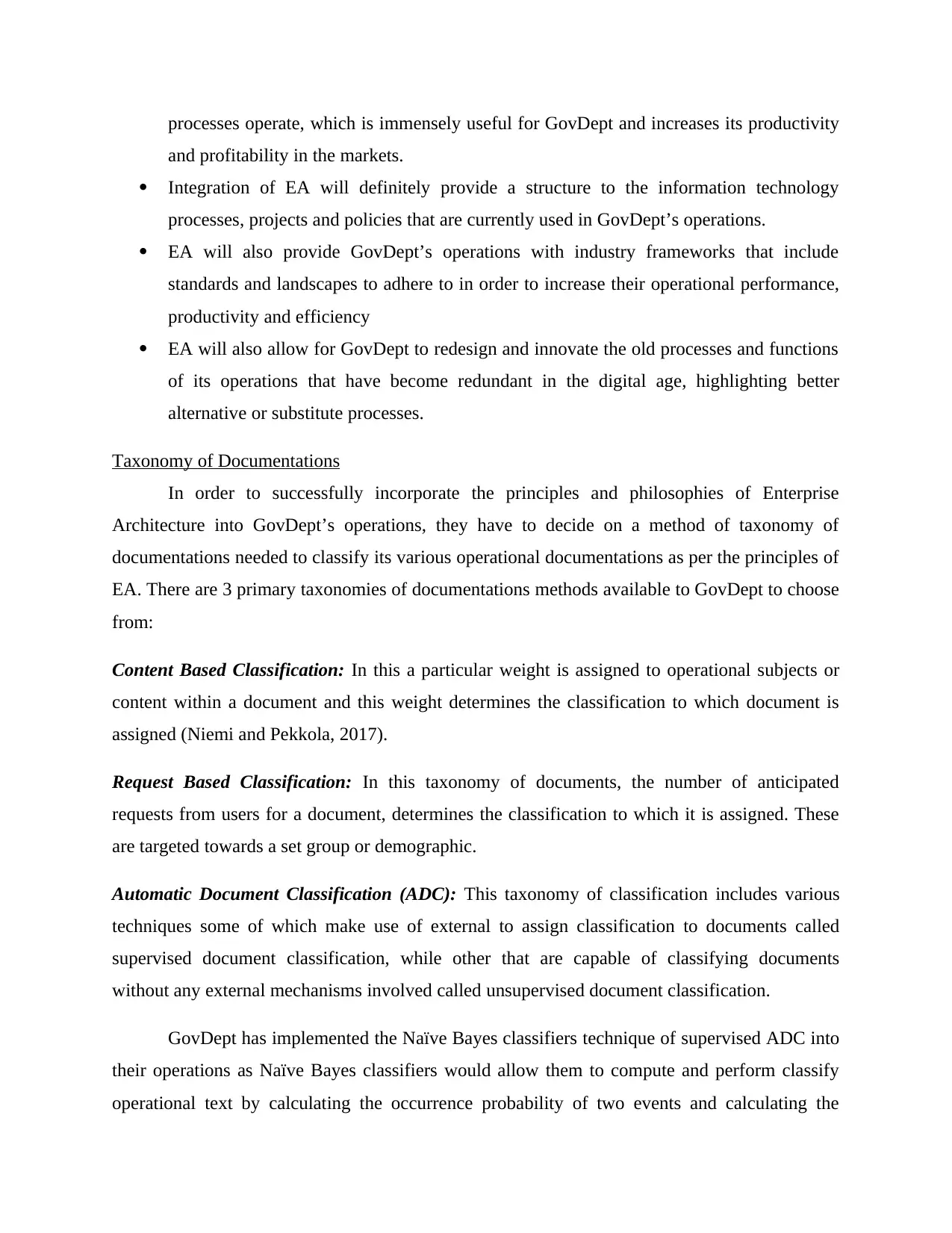
processes operate, which is immensely useful for GovDept and increases its productivity
and profitability in the markets.
Integration of EA will definitely provide a structure to the information technology
processes, projects and policies that are currently used in GovDept’s operations.
EA will also provide GovDept’s operations with industry frameworks that include
standards and landscapes to adhere to in order to increase their operational performance,
productivity and efficiency
EA will also allow for GovDept to redesign and innovate the old processes and functions
of its operations that have become redundant in the digital age, highlighting better
alternative or substitute processes.
Taxonomy of Documentations
In order to successfully incorporate the principles and philosophies of Enterprise
Architecture into GovDept’s operations, they have to decide on a method of taxonomy of
documentations needed to classify its various operational documentations as per the principles of
EA. There are 3 primary taxonomies of documentations methods available to GovDept to choose
from:
Content Based Classification: In this a particular weight is assigned to operational subjects or
content within a document and this weight determines the classification to which document is
assigned (Niemi and Pekkola, 2017).
Request Based Classification: In this taxonomy of documents, the number of anticipated
requests from users for a document, determines the classification to which it is assigned. These
are targeted towards a set group or demographic.
Automatic Document Classification (ADC): This taxonomy of classification includes various
techniques some of which make use of external to assign classification to documents called
supervised document classification, while other that are capable of classifying documents
without any external mechanisms involved called unsupervised document classification.
GovDept has implemented the Naïve Bayes classifiers technique of supervised ADC into
their operations as Naïve Bayes classifiers would allow them to compute and perform classify
operational text by calculating the occurrence probability of two events and calculating the
and profitability in the markets.
Integration of EA will definitely provide a structure to the information technology
processes, projects and policies that are currently used in GovDept’s operations.
EA will also provide GovDept’s operations with industry frameworks that include
standards and landscapes to adhere to in order to increase their operational performance,
productivity and efficiency
EA will also allow for GovDept to redesign and innovate the old processes and functions
of its operations that have become redundant in the digital age, highlighting better
alternative or substitute processes.
Taxonomy of Documentations
In order to successfully incorporate the principles and philosophies of Enterprise
Architecture into GovDept’s operations, they have to decide on a method of taxonomy of
documentations needed to classify its various operational documentations as per the principles of
EA. There are 3 primary taxonomies of documentations methods available to GovDept to choose
from:
Content Based Classification: In this a particular weight is assigned to operational subjects or
content within a document and this weight determines the classification to which document is
assigned (Niemi and Pekkola, 2017).
Request Based Classification: In this taxonomy of documents, the number of anticipated
requests from users for a document, determines the classification to which it is assigned. These
are targeted towards a set group or demographic.
Automatic Document Classification (ADC): This taxonomy of classification includes various
techniques some of which make use of external to assign classification to documents called
supervised document classification, while other that are capable of classifying documents
without any external mechanisms involved called unsupervised document classification.
GovDept has implemented the Naïve Bayes classifiers technique of supervised ADC into
their operations as Naïve Bayes classifiers would allow them to compute and perform classify
operational text by calculating the occurrence probability of two events and calculating the
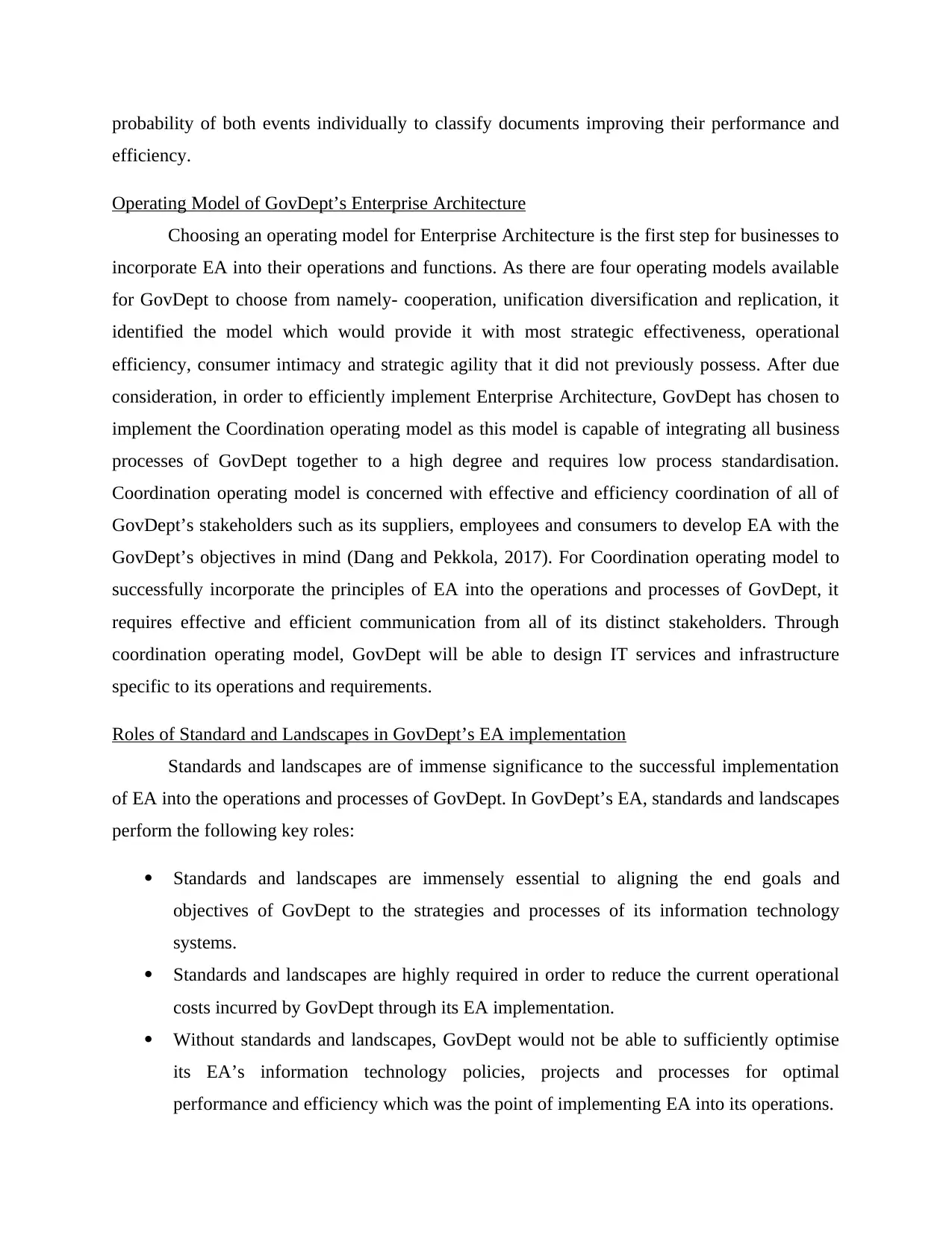
probability of both events individually to classify documents improving their performance and
efficiency.
Operating Model of GovDept’s Enterprise Architecture
Choosing an operating model for Enterprise Architecture is the first step for businesses to
incorporate EA into their operations and functions. As there are four operating models available
for GovDept to choose from namely- cooperation, unification diversification and replication, it
identified the model which would provide it with most strategic effectiveness, operational
efficiency, consumer intimacy and strategic agility that it did not previously possess. After due
consideration, in order to efficiently implement Enterprise Architecture, GovDept has chosen to
implement the Coordination operating model as this model is capable of integrating all business
processes of GovDept together to a high degree and requires low process standardisation.
Coordination operating model is concerned with effective and efficiency coordination of all of
GovDept’s stakeholders such as its suppliers, employees and consumers to develop EA with the
GovDept’s objectives in mind (Dang and Pekkola, 2017). For Coordination operating model to
successfully incorporate the principles of EA into the operations and processes of GovDept, it
requires effective and efficient communication from all of its distinct stakeholders. Through
coordination operating model, GovDept will be able to design IT services and infrastructure
specific to its operations and requirements.
Roles of Standard and Landscapes in GovDept’s EA implementation
Standards and landscapes are of immense significance to the successful implementation
of EA into the operations and processes of GovDept. In GovDept’s EA, standards and landscapes
perform the following key roles:
Standards and landscapes are immensely essential to aligning the end goals and
objectives of GovDept to the strategies and processes of its information technology
systems.
Standards and landscapes are highly required in order to reduce the current operational
costs incurred by GovDept through its EA implementation.
Without standards and landscapes, GovDept would not be able to sufficiently optimise
its EA’s information technology policies, projects and processes for optimal
performance and efficiency which was the point of implementing EA into its operations.
efficiency.
Operating Model of GovDept’s Enterprise Architecture
Choosing an operating model for Enterprise Architecture is the first step for businesses to
incorporate EA into their operations and functions. As there are four operating models available
for GovDept to choose from namely- cooperation, unification diversification and replication, it
identified the model which would provide it with most strategic effectiveness, operational
efficiency, consumer intimacy and strategic agility that it did not previously possess. After due
consideration, in order to efficiently implement Enterprise Architecture, GovDept has chosen to
implement the Coordination operating model as this model is capable of integrating all business
processes of GovDept together to a high degree and requires low process standardisation.
Coordination operating model is concerned with effective and efficiency coordination of all of
GovDept’s stakeholders such as its suppliers, employees and consumers to develop EA with the
GovDept’s objectives in mind (Dang and Pekkola, 2017). For Coordination operating model to
successfully incorporate the principles of EA into the operations and processes of GovDept, it
requires effective and efficient communication from all of its distinct stakeholders. Through
coordination operating model, GovDept will be able to design IT services and infrastructure
specific to its operations and requirements.
Roles of Standard and Landscapes in GovDept’s EA implementation
Standards and landscapes are of immense significance to the successful implementation
of EA into the operations and processes of GovDept. In GovDept’s EA, standards and landscapes
perform the following key roles:
Standards and landscapes are immensely essential to aligning the end goals and
objectives of GovDept to the strategies and processes of its information technology
systems.
Standards and landscapes are highly required in order to reduce the current operational
costs incurred by GovDept through its EA implementation.
Without standards and landscapes, GovDept would not be able to sufficiently optimise
its EA’s information technology policies, projects and processes for optimal
performance and efficiency which was the point of implementing EA into its operations.
⊘ This is a preview!⊘
Do you want full access?
Subscribe today to unlock all pages.

Trusted by 1+ million students worldwide
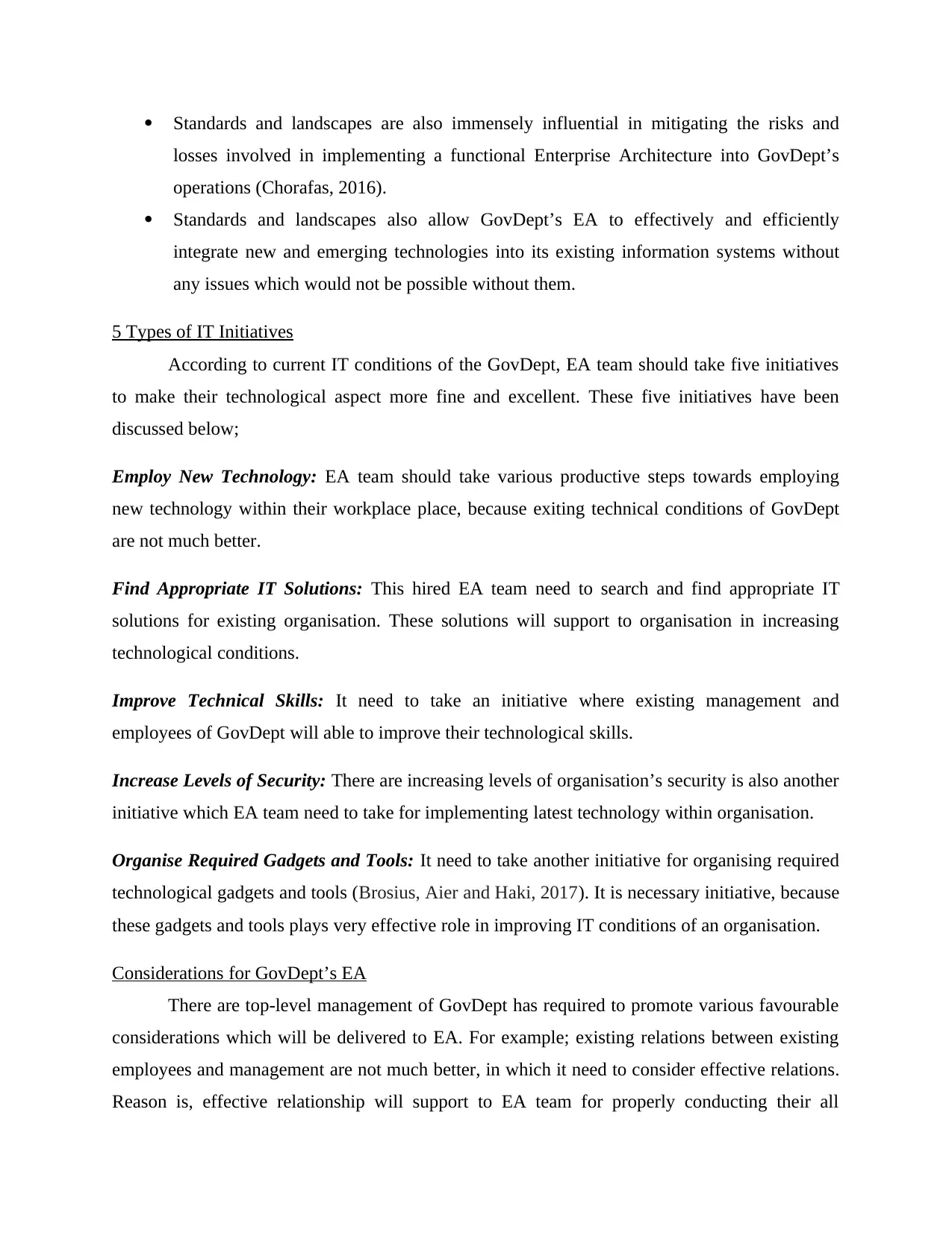
Standards and landscapes are also immensely influential in mitigating the risks and
losses involved in implementing a functional Enterprise Architecture into GovDept’s
operations (Chorafas, 2016).
Standards and landscapes also allow GovDept’s EA to effectively and efficiently
integrate new and emerging technologies into its existing information systems without
any issues which would not be possible without them.
5 Types of IT Initiatives
According to current IT conditions of the GovDept, EA team should take five initiatives
to make their technological aspect more fine and excellent. These five initiatives have been
discussed below;
Employ New Technology: EA team should take various productive steps towards employing
new technology within their workplace place, because exiting technical conditions of GovDept
are not much better.
Find Appropriate IT Solutions: This hired EA team need to search and find appropriate IT
solutions for existing organisation. These solutions will support to organisation in increasing
technological conditions.
Improve Technical Skills: It need to take an initiative where existing management and
employees of GovDept will able to improve their technological skills.
Increase Levels of Security: There are increasing levels of organisation’s security is also another
initiative which EA team need to take for implementing latest technology within organisation.
Organise Required Gadgets and Tools: It need to take another initiative for organising required
technological gadgets and tools (Brosius, Aier and Haki, 2017). It is necessary initiative, because
these gadgets and tools plays very effective role in improving IT conditions of an organisation.
Considerations for GovDept’s EA
There are top-level management of GovDept has required to promote various favourable
considerations which will be delivered to EA. For example; existing relations between existing
employees and management are not much better, in which it need to consider effective relations.
Reason is, effective relationship will support to EA team for properly conducting their all
losses involved in implementing a functional Enterprise Architecture into GovDept’s
operations (Chorafas, 2016).
Standards and landscapes also allow GovDept’s EA to effectively and efficiently
integrate new and emerging technologies into its existing information systems without
any issues which would not be possible without them.
5 Types of IT Initiatives
According to current IT conditions of the GovDept, EA team should take five initiatives
to make their technological aspect more fine and excellent. These five initiatives have been
discussed below;
Employ New Technology: EA team should take various productive steps towards employing
new technology within their workplace place, because exiting technical conditions of GovDept
are not much better.
Find Appropriate IT Solutions: This hired EA team need to search and find appropriate IT
solutions for existing organisation. These solutions will support to organisation in increasing
technological conditions.
Improve Technical Skills: It need to take an initiative where existing management and
employees of GovDept will able to improve their technological skills.
Increase Levels of Security: There are increasing levels of organisation’s security is also another
initiative which EA team need to take for implementing latest technology within organisation.
Organise Required Gadgets and Tools: It need to take another initiative for organising required
technological gadgets and tools (Brosius, Aier and Haki, 2017). It is necessary initiative, because
these gadgets and tools plays very effective role in improving IT conditions of an organisation.
Considerations for GovDept’s EA
There are top-level management of GovDept has required to promote various favourable
considerations which will be delivered to EA. For example; existing relations between existing
employees and management are not much better, in which it need to consider effective relations.
Reason is, effective relationship will support to EA team for properly conducting their all
Paraphrase This Document
Need a fresh take? Get an instant paraphrase of this document with our AI Paraphraser
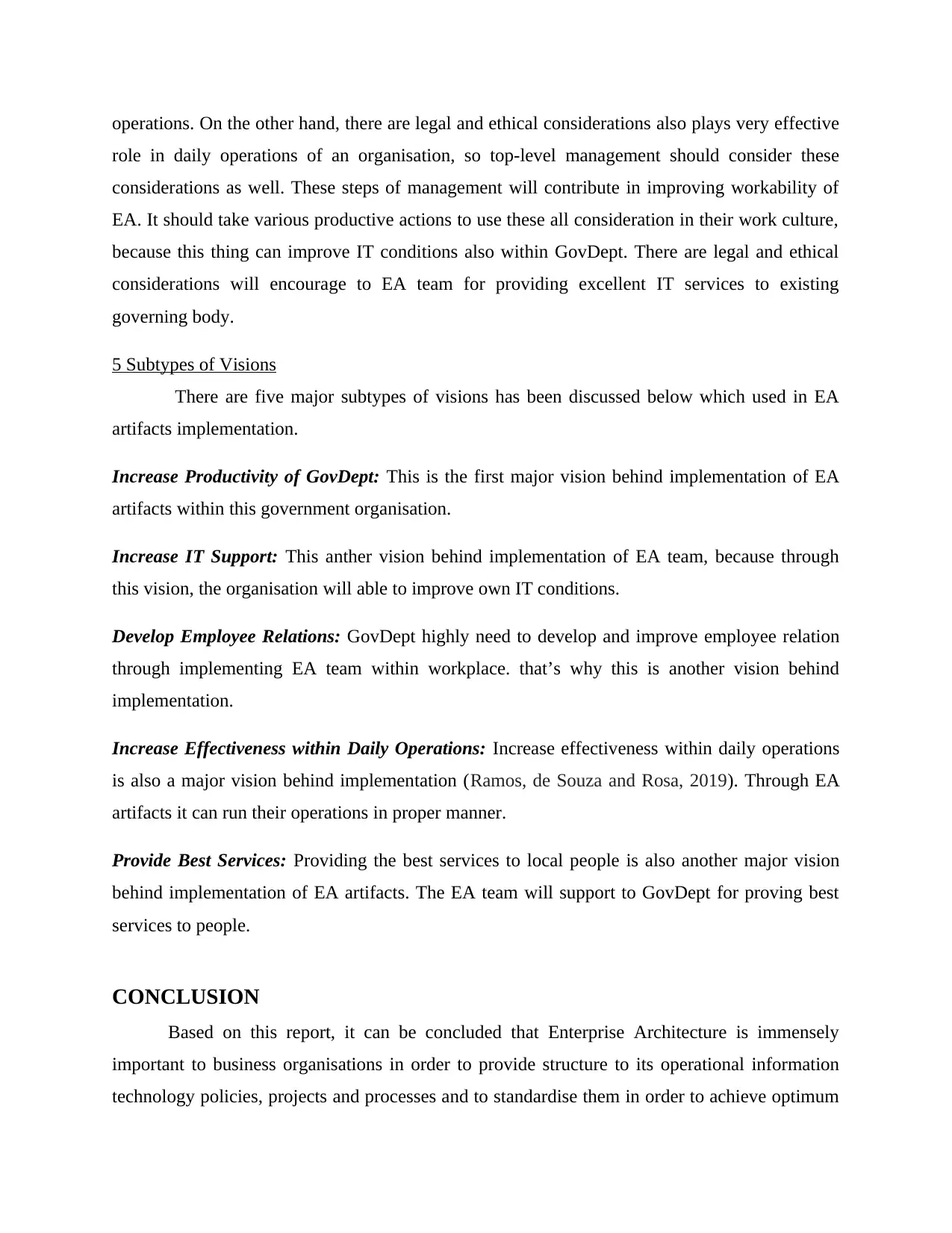
operations. On the other hand, there are legal and ethical considerations also plays very effective
role in daily operations of an organisation, so top-level management should consider these
considerations as well. These steps of management will contribute in improving workability of
EA. It should take various productive actions to use these all consideration in their work culture,
because this thing can improve IT conditions also within GovDept. There are legal and ethical
considerations will encourage to EA team for providing excellent IT services to existing
governing body.
5 Subtypes of Visions
There are five major subtypes of visions has been discussed below which used in EA
artifacts implementation.
Increase Productivity of GovDept: This is the first major vision behind implementation of EA
artifacts within this government organisation.
Increase IT Support: This anther vision behind implementation of EA team, because through
this vision, the organisation will able to improve own IT conditions.
Develop Employee Relations: GovDept highly need to develop and improve employee relation
through implementing EA team within workplace. that’s why this is another vision behind
implementation.
Increase Effectiveness within Daily Operations: Increase effectiveness within daily operations
is also a major vision behind implementation (Ramos, de Souza and Rosa, 2019). Through EA
artifacts it can run their operations in proper manner.
Provide Best Services: Providing the best services to local people is also another major vision
behind implementation of EA artifacts. The EA team will support to GovDept for proving best
services to people.
CONCLUSION
Based on this report, it can be concluded that Enterprise Architecture is immensely
important to business organisations in order to provide structure to its operational information
technology policies, projects and processes and to standardise them in order to achieve optimum
role in daily operations of an organisation, so top-level management should consider these
considerations as well. These steps of management will contribute in improving workability of
EA. It should take various productive actions to use these all consideration in their work culture,
because this thing can improve IT conditions also within GovDept. There are legal and ethical
considerations will encourage to EA team for providing excellent IT services to existing
governing body.
5 Subtypes of Visions
There are five major subtypes of visions has been discussed below which used in EA
artifacts implementation.
Increase Productivity of GovDept: This is the first major vision behind implementation of EA
artifacts within this government organisation.
Increase IT Support: This anther vision behind implementation of EA team, because through
this vision, the organisation will able to improve own IT conditions.
Develop Employee Relations: GovDept highly need to develop and improve employee relation
through implementing EA team within workplace. that’s why this is another vision behind
implementation.
Increase Effectiveness within Daily Operations: Increase effectiveness within daily operations
is also a major vision behind implementation (Ramos, de Souza and Rosa, 2019). Through EA
artifacts it can run their operations in proper manner.
Provide Best Services: Providing the best services to local people is also another major vision
behind implementation of EA artifacts. The EA team will support to GovDept for proving best
services to people.
CONCLUSION
Based on this report, it can be concluded that Enterprise Architecture is immensely
important to business organisations in order to provide structure to its operational information
technology policies, projects and processes and to standardise them in order to achieve optimum
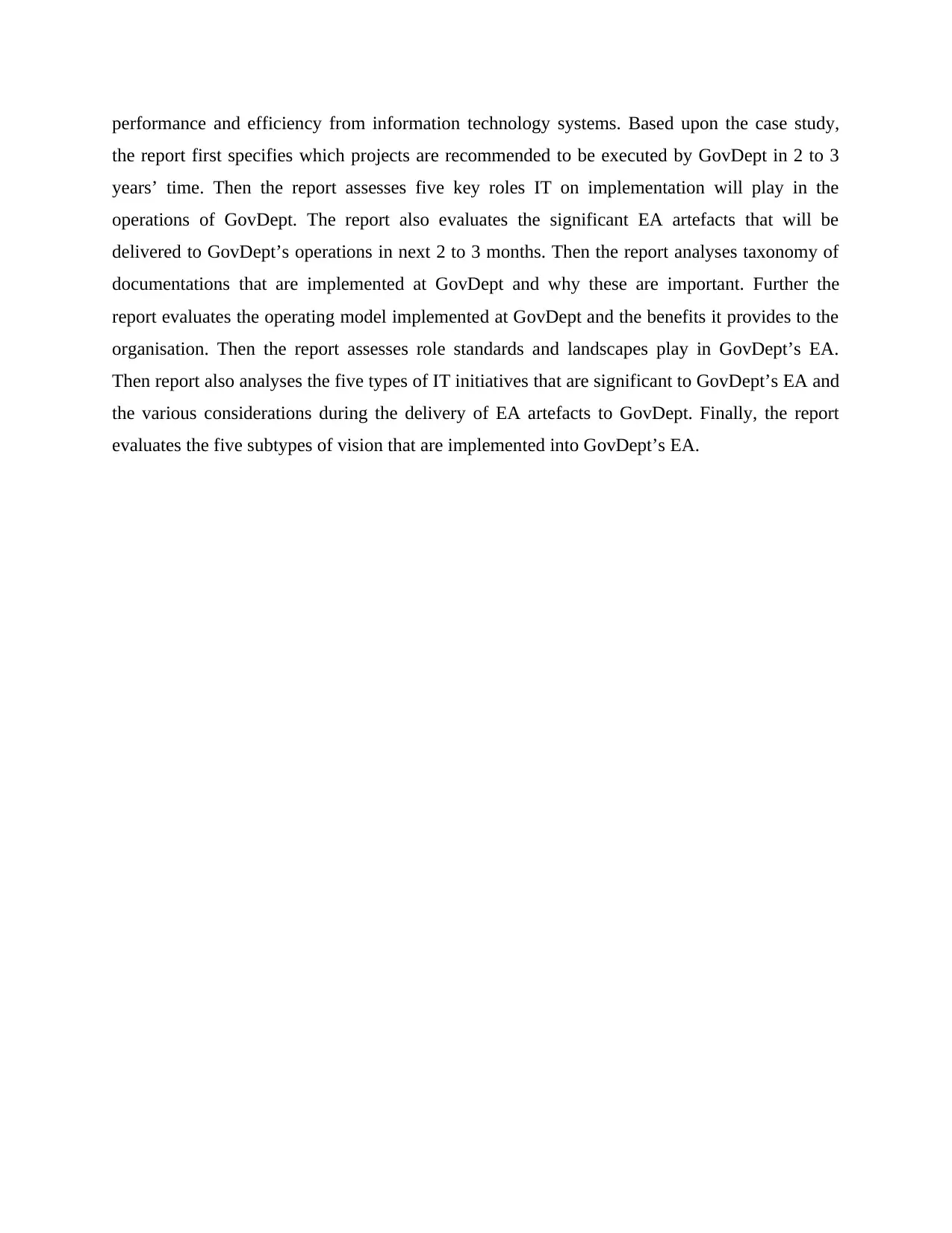
performance and efficiency from information technology systems. Based upon the case study,
the report first specifies which projects are recommended to be executed by GovDept in 2 to 3
years’ time. Then the report assesses five key roles IT on implementation will play in the
operations of GovDept. The report also evaluates the significant EA artefacts that will be
delivered to GovDept’s operations in next 2 to 3 months. Then the report analyses taxonomy of
documentations that are implemented at GovDept and why these are important. Further the
report evaluates the operating model implemented at GovDept and the benefits it provides to the
organisation. Then the report assesses role standards and landscapes play in GovDept’s EA.
Then report also analyses the five types of IT initiatives that are significant to GovDept’s EA and
the various considerations during the delivery of EA artefacts to GovDept. Finally, the report
evaluates the five subtypes of vision that are implemented into GovDept’s EA.
the report first specifies which projects are recommended to be executed by GovDept in 2 to 3
years’ time. Then the report assesses five key roles IT on implementation will play in the
operations of GovDept. The report also evaluates the significant EA artefacts that will be
delivered to GovDept’s operations in next 2 to 3 months. Then the report analyses taxonomy of
documentations that are implemented at GovDept and why these are important. Further the
report evaluates the operating model implemented at GovDept and the benefits it provides to the
organisation. Then the report assesses role standards and landscapes play in GovDept’s EA.
Then report also analyses the five types of IT initiatives that are significant to GovDept’s EA and
the various considerations during the delivery of EA artefacts to GovDept. Finally, the report
evaluates the five subtypes of vision that are implemented into GovDept’s EA.
⊘ This is a preview!⊘
Do you want full access?
Subscribe today to unlock all pages.

Trusted by 1+ million students worldwide
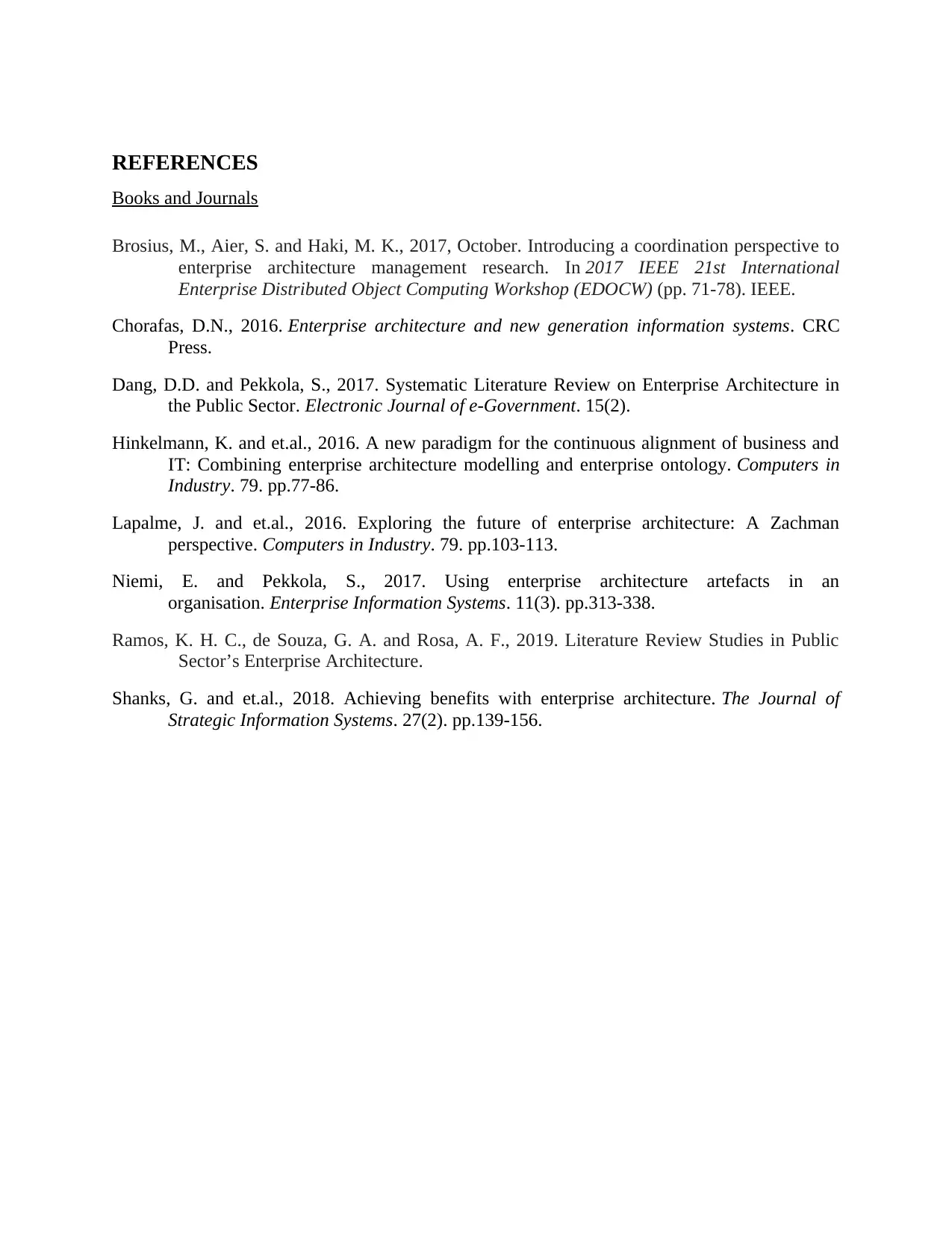
REFERENCES
Books and Journals
Brosius, M., Aier, S. and Haki, M. K., 2017, October. Introducing a coordination perspective to
enterprise architecture management research. In 2017 IEEE 21st International
Enterprise Distributed Object Computing Workshop (EDOCW) (pp. 71-78). IEEE.
Chorafas, D.N., 2016. Enterprise architecture and new generation information systems. CRC
Press.
Dang, D.D. and Pekkola, S., 2017. Systematic Literature Review on Enterprise Architecture in
the Public Sector. Electronic Journal of e-Government. 15(2).
Hinkelmann, K. and et.al., 2016. A new paradigm for the continuous alignment of business and
IT: Combining enterprise architecture modelling and enterprise ontology. Computers in
Industry. 79. pp.77-86.
Lapalme, J. and et.al., 2016. Exploring the future of enterprise architecture: A Zachman
perspective. Computers in Industry. 79. pp.103-113.
Niemi, E. and Pekkola, S., 2017. Using enterprise architecture artefacts in an
organisation. Enterprise Information Systems. 11(3). pp.313-338.
Ramos, K. H. C., de Souza, G. A. and Rosa, A. F., 2019. Literature Review Studies in Public
Sector’s Enterprise Architecture.
Shanks, G. and et.al., 2018. Achieving benefits with enterprise architecture. The Journal of
Strategic Information Systems. 27(2). pp.139-156.
Books and Journals
Brosius, M., Aier, S. and Haki, M. K., 2017, October. Introducing a coordination perspective to
enterprise architecture management research. In 2017 IEEE 21st International
Enterprise Distributed Object Computing Workshop (EDOCW) (pp. 71-78). IEEE.
Chorafas, D.N., 2016. Enterprise architecture and new generation information systems. CRC
Press.
Dang, D.D. and Pekkola, S., 2017. Systematic Literature Review on Enterprise Architecture in
the Public Sector. Electronic Journal of e-Government. 15(2).
Hinkelmann, K. and et.al., 2016. A new paradigm for the continuous alignment of business and
IT: Combining enterprise architecture modelling and enterprise ontology. Computers in
Industry. 79. pp.77-86.
Lapalme, J. and et.al., 2016. Exploring the future of enterprise architecture: A Zachman
perspective. Computers in Industry. 79. pp.103-113.
Niemi, E. and Pekkola, S., 2017. Using enterprise architecture artefacts in an
organisation. Enterprise Information Systems. 11(3). pp.313-338.
Ramos, K. H. C., de Souza, G. A. and Rosa, A. F., 2019. Literature Review Studies in Public
Sector’s Enterprise Architecture.
Shanks, G. and et.al., 2018. Achieving benefits with enterprise architecture. The Journal of
Strategic Information Systems. 27(2). pp.139-156.
1 out of 10
Related Documents
Your All-in-One AI-Powered Toolkit for Academic Success.
+13062052269
info@desklib.com
Available 24*7 on WhatsApp / Email
![[object Object]](/_next/static/media/star-bottom.7253800d.svg)
Unlock your academic potential
Copyright © 2020–2025 A2Z Services. All Rights Reserved. Developed and managed by ZUCOL.





